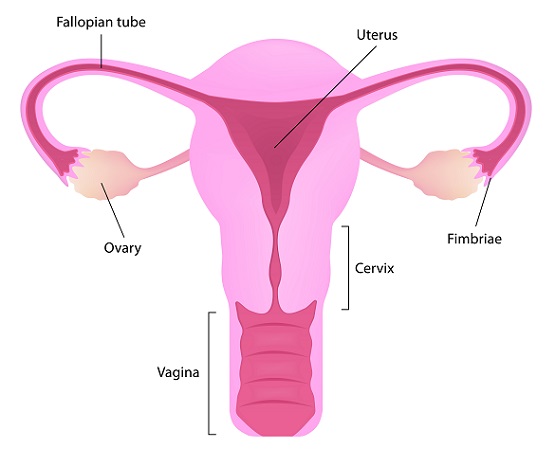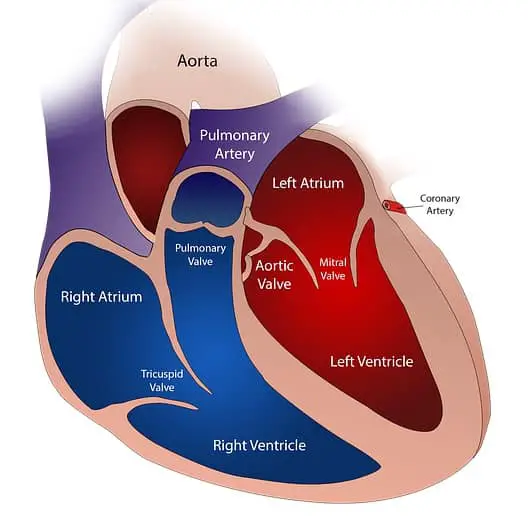The human body is made of many organs with different structures and functions. Of them, there are many hollow organs like
- Heart
- Blood vessels (arteries and veins)
- Stomach (even esophagus)
- Small intestine
- Large intestine
- Urinary bladder
- Uterus
- Fallopian tubules
These organs are hollow internally without any solid or liquid mass. This hollow structure inside them is necessary to perform important functions.
List of Hollow Organs in the Body
Heart
- The heart is the pumping organ of circulation, a hollow muscular organ made of cardiac muscles.
- Anatomically, it can be divided into 4 chambers:
- 2 auricles on the upper and
- 2 ventricles in the lower portion.
- These four chambers are hollow and allow the fluid blood to flow through them.
- On average, the heart pumps 70ml of blood from its ventricles for each stroke.
So, combined with auricles, the entire volume inside the heart could be 140ml. But, this can be greatly enhanced during exercise.
Arteries and veins (Blood vessels)
- These are the pipe-like structures carrying blood to different parts of the body.
- Arteries are the vessels that emerge from the heart. In contrast, the veins are vessels that merge into the heart.
- Due to this arrangement, arteries carry oxygenated blood away from the heart, whereas the veins bring deoxygenated blood to the heart.
Stomach

- This is a major organ of the digestive system. It has an internal volume of about 1.5 liters in an adult.
- It acts as a reserve for food, and here, food is stored temporarily before it is passed on to the small intestine.
- This storage is necessary to treat the food with hydrochloric acid and other digestive juices.
The esophagus is also a hollow organ connecting the buccal cavity with the stomach.
Small intestine

- This is a long pipe-like structure that is a part of the gastrointestinal tract. It starts from the stomach and ends with the large intestine.
It has 3 parts like
- Duodenum,
- Jejunum, and
- Ileum.
- The entire length of this structure is around 5 meters in length.
- It is involved in the digestion of food and absorption of nutrients.
Large intestine
- This is a structure that continues with the small intestine. It is relatively larger and is 1.5 meters in length.
- It is also a hollow organ that is pipe-like and carries the digestive mass from the small intestine to the outside of the body.
It can be divided into different parts as
- Caecum,
- ascending colon,
- transverse colon,
- descending colon,
- sigmoid colon,
- rectum and anus.
- It is involved in absorbing excess water, minerals, and vitamins. It houses friendly bacteria that help form vitamin K and Folic acid.
It temporarily contains feces before being expelled out of the anus.
Gall bladder

- This is a sac-like structure attached to the posterior of the liver.
- It opens into the bile duct.
- It acts as a reservoir for bile juice.
Urinary bladder
- This is a pear-shaped hollow muscular structure at the end of the urinary system.
- The bladder temporarily stores the urine until emptied. It can hold urine up to 600ml.
- It is connected to the kidney through the ureters and opens through the urethra.
Uterus

- This is a major hollow organ present only in females. It is a muscular organ located in the pelvic cavity.
- It has a dimension of 7.5 cm in length and 5 cm in width with muscular walls.
- It accommodates fertilized ova and can grow bigger to accommodate the growing baby. Thus, it nourishes and protects the fetus.
Fallopian tubules

- There are a pair of fallopian tubules in the female reproductive system.
- These are hollow tubes that extend from the uterus to the ovaries.
- Their average length is around 12 centimeters, and they have ciliated epithelium inside, surrounded by three muscular layers.
- The infundibulum collects the ova released by the ovaries. Then, these ova travel through these tubules towards the uterus.
- In one way, they seem to connect the peritoneal cavity to the external of the body through the uterus and vagina.
Other hollow organs
An organ is made up of a group of tissues. However, not all organs have vital functions. Of these less active organs, some are hollow inside, like
a) Trachea and bronchi
b) Esophagus, pharynx
c) Ureters
d) Urethra
e) Cervix
f) Bile duct.
g) Appendix.
Hollow Organs vs. Solid Organs
| Character | Hollow organ | Solid organ |
|---|---|---|
| Size and shape | Mostly lengthy than the width | Size is balanced in terms of length and width |
| Number | Most body organs are hollow | Solid organs are few in number comparatively |
| Ability to contract and dilate | They tend to contract and dilate | Very few of them contract and dilate |
| Multiple layers | Hollow organs are made of layers of tissue around a lumen or space. | Solid organs are made of a mass of tissues without any space within them. |
| Nervous control | They are highly regulated autonomic nervous system. Example: Heart contracts by sympathetic and dilates by parasympathetic stimuli | They are less regulated by the nervous system directly, But are indirectly controlled by the nervous system through the release of hormones. Example: Pancreas is stimulated to synthesize and secrete enzymes and hormones. |
| Function | Mostly involved in the storage and transfer of substances. | Involved in support of the body or metabolism. |
Is the gallbladder a hollow organ?
Yes, the gallbladder is a hollow organ. It stores the bile juice and then releases it into the intestine when needed.
What muscle is found in the walls of hollow organs
The heart wall is made of the cardiac muscle, while the walls of all other hollow organs have smooth muscle.
What is the primary function of hollow organs?
The primary function of hollow organs is to allow movement or storage of fluid and materials.
Is spleen a hollow organ?
No spleen is not a hollow organ and is filled with spongy tissue inside.

